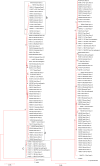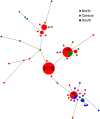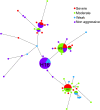Phylogenetic and phenotypic characterization of Fusarium oxysporum f. sp. niveum isolates from Florida-grown watermelon
- PMID: 33764995
- PMCID: PMC7993609
- DOI: 10.1371/journal.pone.0248364
Phylogenetic and phenotypic characterization of Fusarium oxysporum f. sp. niveum isolates from Florida-grown watermelon
Abstract
Fusarium wilt of watermelon (Citrullus lanatus) caused by Fusarium oxysporum f. sp. niveum (Fon), has become an increasing concern of farmers in the southeastern USA, especially in Florida. Management of this disease, most often through the use of resistant cultivars and crop rotation, requires an accurate understanding of an area's pathogen population structure and phenotypic characteristics. This study improved the understanding of the state's pathogen population by completing multilocus sequence analysis (MLSA) of two housekeeping genes (BT and TEF) and two loci (ITS and IGS), aggressiveness and race-determining bioassays on 72 isolates collected between 2011 and 2015 from major watermelon production areas in North, Central, and South Florida. Multilocus sequence analysis (MLSA) failed to group race 3 isolates into a single large clade; moreover, clade membership was not apparently correlated with aggressiveness (which varied both within and between clades), and only slightly with sampling location. The failure of multilocus sequence analysis using four highly conserved housekeeping genes and loci to clearly group and delineate known Fon races provides justification for future whole genome sequencing efforts whose more robust genomic comparisons will provide higher resolution of intra-species genetic distinctions. Consequently, these results suggest that identification of Fon isolates by race determination alone may fail to detect economically important phenotypic characteristics such as aggressiveness leading to inaccurate risk assessment.
Conflict of interest statement
The authors have declared that no competing interests exist.
Figures



References
-
- 2019 Crop production database [Internet]. 2019 [cited August 9 2019]. http://www.fao.org/faostat/en/#data/QC.
-
- Bertucci MB, Jennings KM, Monks DW, Schultheis JR, Louws FJ, Jordan DL, et al.. Critical Period for Weed Control in Grafted and Nongrafted Watermelon Grown in Plasticulture. Weed Science. 2019;67(2):221–8. 10.1017/wsc.2018.76 - DOI
-
- Cantliffe D J., Shaw N L., Stoffella P J., editors. Current trends in cucurbit production in the US. III International Symposium on Cucurbits 731; 2005.
-
- Lievens B, Claes L, Vakalounakis DJ, Vanachter AC, Thomma BP. A robust identification and detection assay to discriminate the cucumber pathogens Fusarium oxysporum f. sp. cucumerinum and f. sp. radicis-cucumerinum. Environmental Microbiology. 2007;9(9):2145–61. 10.1111/j.1462-2920.2007.01329.x - DOI - PubMed
-
- Everts KL, Himmelstein JC. Fusarium wilt of watermelon: Towards sustainable management of a re-emerging plant disease. Crop Protection. 2015;73:93–9. 10.1016/j.cropro.2015.02.019 - DOI
Publication types
MeSH terms
Supplementary concepts
LinkOut - more resources
Full Text Sources
Other Literature Sources
Medical

